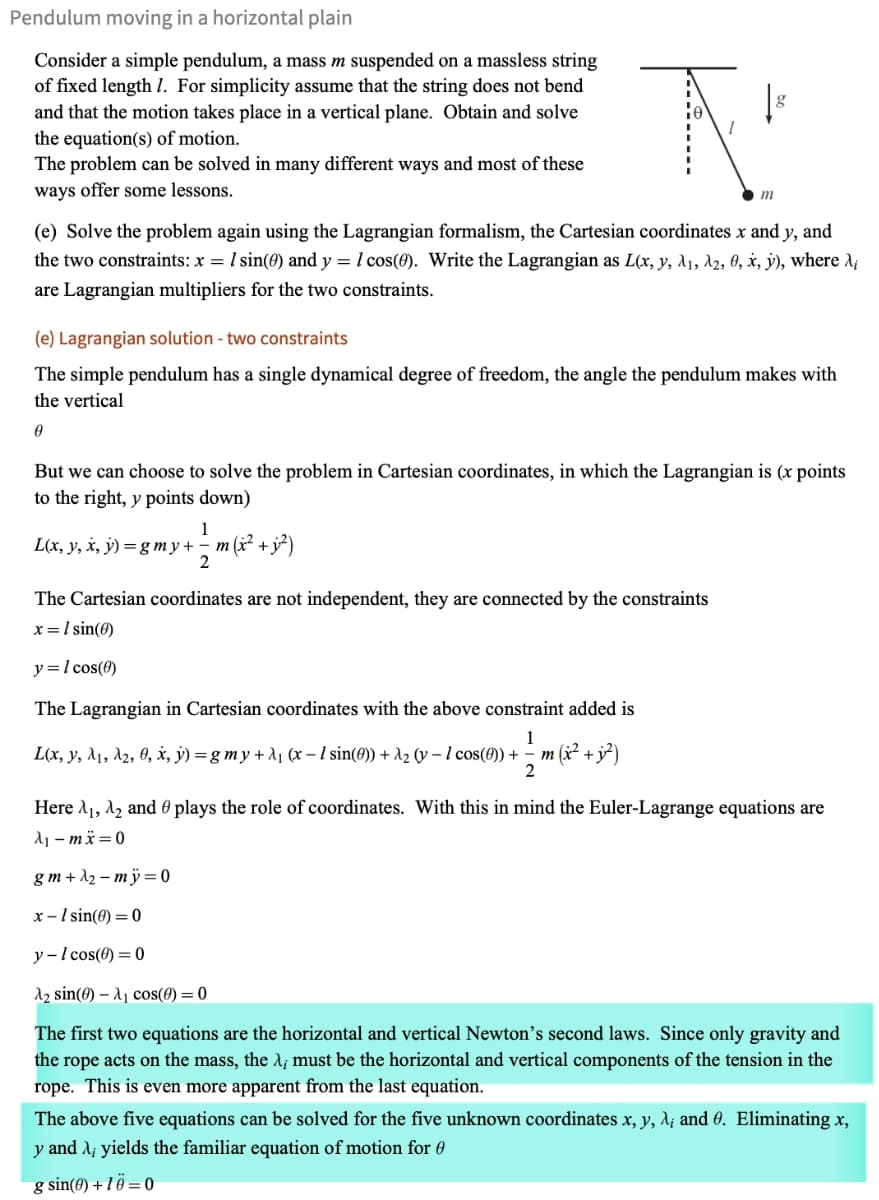₁-mx=0 gm+2-my-0 x-sin(0)=0 y-l cos(0)=0 12 sin() cos(0) = 0 The first two equations are the horizontal and vertical Newton's second laws. Since only gravity and the rope acts on the mass, the λ; must be the horizontal and vertical components of the tension in the rope. This is even more apparent from the last equation. The above five equations can be solved for the five unknown coordinates x, y, λ; and 0. Eliminating x, y and λ; yields the familiar equation of motion for g sin(0)+10=0
₁-mx=0 gm+2-my-0 x-sin(0)=0 y-l cos(0)=0 12 sin() cos(0) = 0 The first two equations are the horizontal and vertical Newton's second laws. Since only gravity and the rope acts on the mass, the λ; must be the horizontal and vertical components of the tension in the rope. This is even more apparent from the last equation. The above five equations can be solved for the five unknown coordinates x, y, λ; and 0. Eliminating x, y and λ; yields the familiar equation of motion for g sin(0)+10=0
Related questions
Question
Please prove the highlighted sections are true.

Transcribed Image Text:Pendulum moving in a horizontal plain
Consider a simple pendulum, a mass m suspended on a massless string
of fixed length 7. For simplicity assume that the string does not bend
and that the motion takes place in a vertical plane. Obtain and solve
the equation(s) of motion.
The problem can be solved in many different ways and most of these
ways offer some lessons.
m
g
(e) Solve the problem again using the Lagrangian formalism, the Cartesian coordinates x and y, and
the two constraints: x = 1 sin(0) and y = cos(0). Write the Lagrangian as L(x, y, A1, A2, 0, x, y), where λi
are Lagrangian multipliers for the two constraints.
(e) Lagrangian solution - two constraints
The simple pendulum has a single dynamical degree of freedom, the angle the pendulum makes with
the vertical
0
But we can choose to solve the problem in Cartesian coordinates, in which the Lagrangian is (x points
to the right, y points down)
L(x, y, x, y)=gmy+
1
2 m (x² + j²)
The Cartesian coordinates are not independent, they are connected by the constraints
x = 1 sin(0)
y = cos(0)
The Lagrangian in Cartesian coordinates with the above constraint added is
1
L(x, y, 1, 2, 0, x, y) =gmy+λ₁ (x - 1 sin()) + 12 (y-l cos()) + ·m (x² + y²)
2
Here 1, 2 and plays the role of coordinates. With this in mind the Euler-Lagrange equations are
λ₁-mx=0
gm+2-my-0
x-sin(0) 0
y-l cos(0)=0
2 sin()₁ cos(0) = 0
The first two equations are the horizontal and vertical Newton's second laws. Since only gravity and
the rope acts on the mass, the λ; must be the horizontal and vertical components of the tension in the
rope. This is even more apparent from the last equation.
The above five equations can be solved for the five unknown coordinates x, y, λ; and 0. Eliminating x,
y and λ, yields the familiar equation of motion for
g sin(0)+10=0
Expert Solution
This question has been solved!
Explore an expertly crafted, step-by-step solution for a thorough understanding of key concepts.
Step by step
Solved in 4 steps with 7 images
